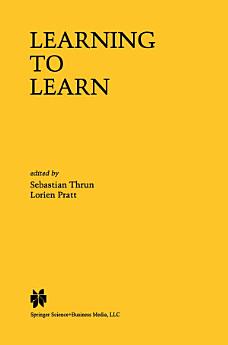Learning to Learn
Sebastian Thrun · Lorien Pratt
ທ.ວ. 2012 · Springer Science & Business Media
ປຶ້ມອີບຸກ
354
ໜ້າ
reportບໍ່ໄດ້ຢັ້ງຢືນການຈັດອັນດັບ ແລະ ຄຳຕິຊົມ ສຶກສາເພີ່ມເຕີມ
ກ່ຽວກັບປຶ້ມ e-book ນີ້
Over the past three decades or so, research on machine learning and data mining has led to a wide variety of algorithms that learn general functions from experience. As machine learning is maturing, it has begun to make the successful transition from academic research to various practical applications. Generic techniques such as decision trees and artificial neural networks, for example, are now being used in various commercial and industrial applications.
Learning to Learn is an exciting new research direction within machine learning. Similar to traditional machine-learning algorithms, the methods described in Learning to Learn induce general functions from experience. However, the book investigates algorithms that can change the way they generalize, i.e., practice the task of learning itself, and improve on it.
To illustrate the utility of learning to learn, it is worthwhile comparing machine learning with human learning. Humans encounter a continual stream of learning tasks. They do not just learn concepts or motor skills, they also learn bias, i.e., they learn how to generalize. As a result, humans are often able to generalize correctly from extremely few examples - often just a single example suffices to teach us a new thing.
A deeper understanding of computer programs that improve their ability to learn can have a large practical impact on the field of machine learning and beyond. In recent years, the field has made significant progress towards a theory of learning to learn along with practical new algorithms, some of which led to impressive results in real-world applications.
Learning to Learn provides a survey of some of the most exciting new research approaches, written by leading researchers in the field. Its objective is to investigate the utility and feasibility of computer programs that can learn how to learn, both from a practical and a theoretical point of view.
Learning to Learn is an exciting new research direction within machine learning. Similar to traditional machine-learning algorithms, the methods described in Learning to Learn induce general functions from experience. However, the book investigates algorithms that can change the way they generalize, i.e., practice the task of learning itself, and improve on it.
To illustrate the utility of learning to learn, it is worthwhile comparing machine learning with human learning. Humans encounter a continual stream of learning tasks. They do not just learn concepts or motor skills, they also learn bias, i.e., they learn how to generalize. As a result, humans are often able to generalize correctly from extremely few examples - often just a single example suffices to teach us a new thing.
A deeper understanding of computer programs that improve their ability to learn can have a large practical impact on the field of machine learning and beyond. In recent years, the field has made significant progress towards a theory of learning to learn along with practical new algorithms, some of which led to impressive results in real-world applications.
Learning to Learn provides a survey of some of the most exciting new research approaches, written by leading researchers in the field. Its objective is to investigate the utility and feasibility of computer programs that can learn how to learn, both from a practical and a theoretical point of view.
ໃຫ້ຄະແນນ e-book ນີ້
ບອກພວກເຮົາວ່າທ່ານຄິດແນວໃດ.
ອ່ານຂໍ້ມູນຂ່າວສານ
ສະມາດໂຟນ ແລະ ແທັບເລັດ
ຕິດຕັ້ງ ແອັບ Google Play Books ສຳລັບ Android ແລະ iPad/iPhone. ມັນຊິ້ງຂໍ້ມູນໂດຍອັດຕະໂນມັດກັບບັນຊີຂອງທ່ານ ແລະ ອະນຸຍາດໃຫ້ທ່ານອ່ານທາງອອນລາຍ ຫຼື ແບບອອບລາຍໄດ້ ບໍ່ວ່າທ່ານຈະຢູ່ໃສ.
ແລັບທັອບ ແລະ ຄອມພິວເຕີ
ທ່ານສາມາດຟັງປຶ້ມສຽງທີ່ຊື້ໃນ Google Play ໂດຍໃຊ້ໂປຣແກຣມທ່ອງເວັບຂອງຄອມພິວເຕີຂອງທ່ານໄດ້.
eReaders ແລະອຸປະກອນອື່ນໆ
ເພື່ອອ່ານໃນອຸປະກອນ e-ink ເຊັ່ນ: Kobo eReader, ທ່ານຈຳເປັນຕ້ອງດາວໂຫຼດໄຟລ໌ ແລະ ໂອນຍ້າຍມັນໄປໃສ່ອຸປະກອນຂອງທ່ານກ່ອນ. ປະຕິບັດຕາມຄຳແນະນຳລະອຽດຂອງ ສູນຊ່ວຍເຫຼືອ ເພື່ອໂອນຍ້າຍໄຟລ໌ໄໃສ່ eReader ທີ່ຮອງຮັບ.






